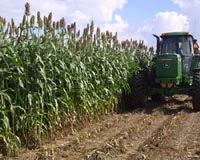 |
Upton NY (SPX) Oct 22, 2009 Scientists at the U.S. Department of Energy's (DOE) Brookhaven National Laboratory have identified a novel enzyme responsible for the formation of suberin - the woody, waxy, cell-wall substance found in cork. While effective at keeping wine inside a bottle, suberin's most important function in plants is to control water and nutrient transportation and keep pathogens out. Adjusting the permeability of plant tissues by genetically manipulating the expression of this enzyme could lead to easier agricultural production of crops used for biofuels. The research, led by Brookhaven biologists Chang-Jun Liu and Jin-Ying Gou, will be published online in the Proceedings of the National Academy of Sciences the week of October 19, 2009.
Normal seeds and seeds deficient in HHT "We sought to understand the synthesis of the 'wall-bound' phenolic component of different biopolymers, including this important suberin polymer, by identifying the enzymes responsible for their construction," said Liu. This information could eventually be used to modify plants for agricultural purposes, including improved biomass production. "Knowing which enzymes do what may allow the properties of polymers to be tailored for specific purposes through either plant breeding or genetic engineering," Liu explained. In this experiment, Liu and colleagues analyzed a strain of Arabidopsis (a common experimental plant) that had been genetically modified to disrupt the expression of a gene that codes for an enzyme now known as hydroxyacid hydroxycinnamoyltransferase (HHT). Chemical analysis showed that "knocking out" the HHT gene led to a deficiency of suberin phenolics, indicating that HHT is the enzyme responsible for biosynthesis of the polymer. Liu and his colleagues then isolated the gene and expressed it in bacteria to further characterize its function. The team also demonstrated that the HHT-deficient plants were much more permeable to salt in solution than their wild-type counterparts. This finding, together with the ubiquitous presence of suberin in plant root tissues that control water and salt uptake, suggests that suberin plays an important role in the adaptation of plants to their terrestrial habitats. Harnessing the mechanism responsible for suberin production might therefore allow scientists to create crop breeds tailored to thrive in specific - even harsh - environments, an important milestone on the road toward economically efficient biofuel production. "Identifying the key biosynthetic enzymes and understanding suberin production may be particularly important for growing plants on the marginal soils that have been proposed for use in farming bioenergy crops," Liu said. For example, if certain breeds can be created that are more adept at absorbing and storing water and nutrients, the crops could be farmed in much drier climates - maybe even the desert. In addition, the team's finding that modifications in suberin phenolic production can alter plants' tolerance to salt suggests that the newly-identified gene might be used to generate crops able to grow under salty conditions. These approaches to biofuel agriculture would leave more-fertile land open for food crops, helping to strike a much-needed balance between the nutrition and energy needs of the world.
Synergistic studies A coordinated effort to modify both polymers could potentially make plants easier to digest for the production of biofuels, while, at the same time, redirecting photosynthetic carbon to improve carbon-sequestration efforts. Liu's group is currently engaged in proof-of-concept experiments to demonstrate this approach. Share This Article With Planet Earth
Related Links DOE/Brookhaven National Laboratory Bio Fuel Technology and Application News
 DOE Awards FDC Enterprises Funding For Cellulosic Ethanol Feedstock Delivery System Development
DOE Awards FDC Enterprises Funding For Cellulosic Ethanol Feedstock Delivery System DevelopmentLandover MD (SPX) Oct 21, 2009 The U.S. Department of Energy (DOE) recently announced that FDC Enterprises of Columbus, Ohio, was one of five winners to share in a $21 million grant to develop supply systems to handle and deliver feedstocks for cellulosic biofuels production. Cellulosic biofuels can be derived from a diverse number of feedstocks including switchgrass, woodchips, and agricultural residues. ... read more |
|
| The content herein, unless otherwise known to be public domain, are Copyright 1995-2009 - SpaceDaily. AFP and UPI Wire Stories are copyright Agence France-Presse and United Press International. ESA Portal Reports are copyright European Space Agency. All NASA sourced material is public domain. Additional copyrights may apply in whole or part to other bona fide parties. Advertising does not imply endorsement,agreement or approval of any opinions, statements or information provided by SpaceDaily on any Web page published or hosted by SpaceDaily. Privacy Statement |